When was the last time you went to a drive in movie? Admittedly, the pickings are pretty scarce these days. At last count there were only 559 drive-in screens at 317 locations remaining in the United States and even less in Canada and Australia. While many states have multiple outdoor venues to watch film, many only have one or just a few.
This is a far cry from the glory days of the Drive-in. In the late 50’s, some estimates have the number of venues reaching over 4600. The drive-in is a uniquely American business and mostly mom and pop operations. While other countries have copied them, their numbers fall far short of America in its heyday.
From the introduction of home video equipment and cable channels in the late seventies to the most recent cost of conversion from analog (photochemical film) to digital (disc or server based) have been cited as reasons the drive-ins are going out of business. Obviously, these are contributing factors. But the sharp downturn over the years is due to multiple factors many having nothing to do with technology.
The migration of populations from city to suburbs, the cost of the land as those suburbs became more valuable, the building of malls with movie theaters making them convenient to suburbia, the limitation of drive-in hours to after dark and how daylight savings time made that worse, cars getting smaller because of the cost of gas, multiple gas crises as a reason to not even start the car at all, even down to neck rests blocking the back seat view all provided reasons to stay home and caused drive-ins to close permanently. In Beaver Falls, PA, even Mother Nature got involved when a tornado hit the Spotlight 88 Drive-In. Life in America was changing and drive-ins, by their very nature, could not keep up.
On June 6th, it will be ‘National Drive In Movie day’. It celebrates the first opening of an installation that made it easy for families to go to the movies and dating couples a private place to either experience the movie or each other. According to DriveInMovie.com, “June 6th, 1933, Richard Hollingshead opened the first, permanent drive-in theater in Camden, NJ.” He was granted a patent in May of 1933 and a month later he opened the first drive-in and called it the Automobile Movie Theatre. Hollingshead never made any money off his idea and sold it to a new owner who changed the venue location.

The next year, 1934, a second drive-in was to open in Orefield, Pennsylvania, and had more luck than Hollingshead’s project. This year celebrates the 85th year of continuous service from Shankweiler’s Drive-in “making it the oldest continuous operating drive-in in the world.” Shankweiler’s has changed owners a number of times, but it has never been closed for a season.
DriveInMovies.com says, “…with any luck, the number of drive-in theaters in the U.S. will increase this year for the first time in decades. While one year does not make a trend, it would certainly be refreshing to see this authentic American past time make a comeback.“
DriveInMovie.com maintains a database to all currently operating drive-in theaters in the world as well as a list of closed theaters.
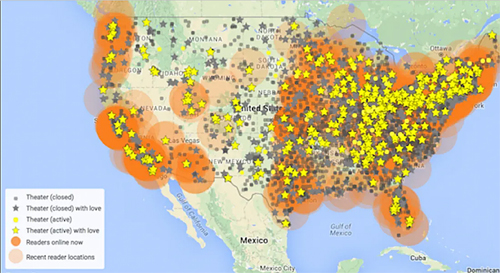
From a technical standpoint, drive-ins have not changed that much over the years. Sound was the initial challenge. In the beginning years, theater owners tried keeping the speakers near the screen but not everyone liked keeping their windows open. The cars in the front complained about how loud the film was. The cars in the back could barely hear and, depending on how big a parking area it was, the sound would not be in sync with the picture. Also, there were complaints from the developing neighborhoods in the homes nearby.
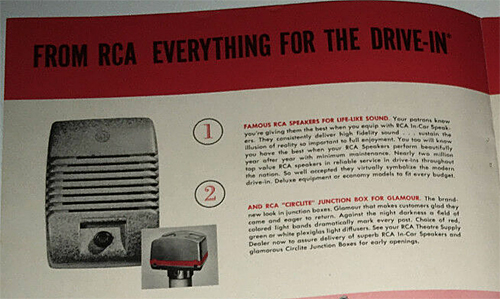
RCA came to the rescue. In 1941, they invented the drive-in car speaker system that would deliver the sound to each individual car. Each speaker had a volume control and so each car could adjust the sound to the liking of the occupants. Complaints from growing suburbia went away but new problems came from customers forgetting to replace the speaker back on the holder. They would start to drive away with it still hanging in the car window.
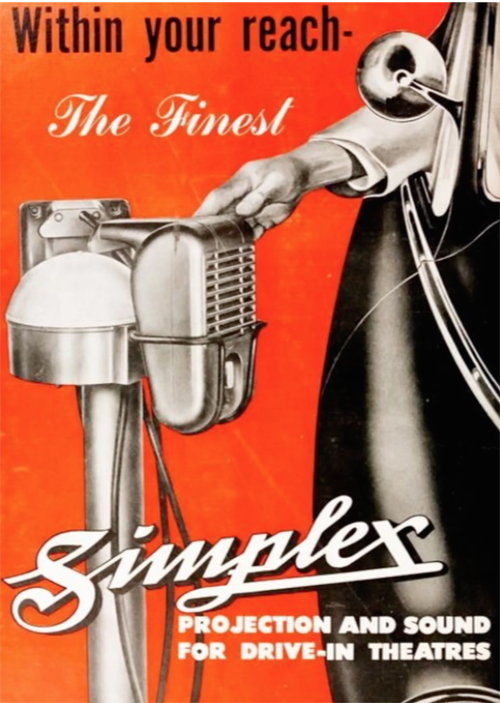
As car manufacturers began to offer more sound options as standard equipment, the 1970’s brought the car radio into play as an important part in delivering the soundtrack to the customer. They kept some of the speakers on the poles so they didn’t have to turn away customers during the transition. Eventually, the problem of forgetting about the speaker in the windows became a thing of the past.
Initially, standard AM radio low power transmitters were used. As film progressed to higher quality soundtracks, drive-ins began to use FM and its stereo capabilities. Today, almost all theaters transmit their sound via FM Radio. The first drive-ins to use FM generally meant a transmitter that was intended for the home theater rather than a professional venue. But some companies are filling that void with professional gear to deliver a reliable, full fidelity signal to the customer.
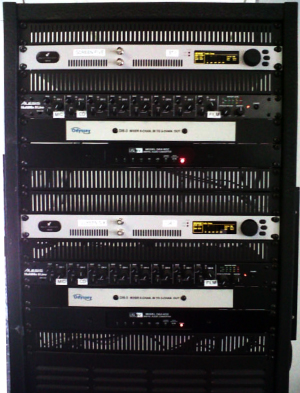
In the beginning, going to the movies meant getting dressed up to go out on a night on the town (Yes, people did that in the 50’s and early 60’s). Drive-ins provided America with the option to just get in the car and go. Their kids could come in their pajamas and curl up with blankets in the back seat. In fact, the kids were welcome! Usually to go “in town” to a movie required the family hire a babysitter (adding another cost to the evening). At the drive-in the kids usually got in for free or at least at a reduced rate. “Come as you are and sit in your car” was the way the newspaper ads put it.
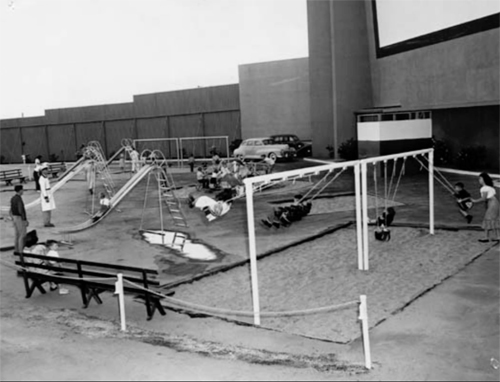
When television first started draining off the audience and keeping people home, the theaters had their first modification crisis as wide screen productions became immediately popular for films. All the more elaborate drive-in screens from the early fifties currently in existence have “wings” added to them to accommodate the conversion from Academy ratios (1.33:1) to most of the wide screen ratios.
In the seventies and eighties the advent of cable TV, satellites, and VCR’s were the first challenges faced by drive-ins regarding the state of the art of technology. Now families could just stay home to watch a current movie. The whole family could be in their pajamas and no one would care!
The cable into the home first provided HBO then Showtime with movies just out of the theatre circuit. These were the days when the movies opened in the bigger cities and got to the drive-ins three weeks or more later. About the same time the movie was getting to your local drive-in, HBO was starting to play it out to your TV set. (A serendipitous note here – HBO began its life on November 8, 1972 in Wilkes Barre, PA, just a little over an hour’s drive from Orefield, PA, where Shankweiler’s Drive-in was located).
Then the VCR’s came on the market. In 1975, Sony launched its Betamax recording system. Two years later, the VHS (for Video Home System) format came on the market. Initially, the cost for these units was considerable ($1000 or more was not unheard of) but the prices quickly dropped. It wasn’t long after that local shops began to pop up carrying movies for rent. These, like the drive-ins, grew out of mom and pop entrepreneurs. Pick-up a couple of movies on the way home on a Friday evening and you have programs for the kids and for mom and dad to watch after the kids had gone to bed.
Speaking of getting the kids to bed, one reason VHS won out over Betamax wasn’t necessarily just because it could record a two hour full-length movie (Betamax tape maxed out at just one hour). As Wired magazine reported in their June 4, 2010, issue, “Sony reportedly would not let pornographic content be put on Betamax tapes while JVC and the VHS consortium had no such qualms.” Drive-ins did get involved in showing X-Rated product, but they also faced an outraged public over it since their screens could sometimes be seen outside of the confines of their parking lot.
About this the same time, the drive-in on the outskirts of town discovered it now was in the middle of several new housing developments. Couple this with families facing gas shortages, multiplexes springing up in the new megamall and developers lusting after the huge lot of land just sitting empty most of the time and closures seemed inevitable.
It wasn’t until the conversion to digital brought the prospect of redoing all the technical equipment that the last holdouts started throwing in the towel. The projectors and sound systems had lasted so many years by just keeping up with the maintenance. Changing over to file based systems required more than just a state of the art projector (although that was a major financial consideration). Overall, each screen was going to require $60,000 or more! By and large, these owners didn’t have deep pockets. If they weren’t owned by a large multiscreen operation that could amortize that size of an investment, they were likely not to make it!
One that is surviving is the Rodeo Drive-In in Bremerton, Washington. Their location was built in 1949. Since 1986, the Rodeo has been owned by Jack and Cindy Ondracek and family. According to their website, “Today, with three screens and a car capacity of 1000, they are the largest outdoor theatre complex in Washington State.” In 2012, they converted all three of their screens to digital. They tell their story of the conversion here.
As other operators who had been around since the 50’s or 60’s were getting older, they were looking to find a way to retire. If a property management group came calling and offered up to $500,000 to buy the drive-in (for its land value), most of the operators saw it was a way to retire comfortably. As digital moved forward they could no longer get product from the distributors. It was time they put up the “Closed Permanently” sign. Before long a real estate developer called on them with a substantial check in his hand for their property.
It was easy for the developers to erase all vestiges of the theater. The only substantial demolition required was tearing down the concession stand and, depending on the venue, the screen. Many screens were just attached to wood poles or a few girders for support. If they were more elaborate, it might take longer. The rest of the property was at most asphalt parking spaces.
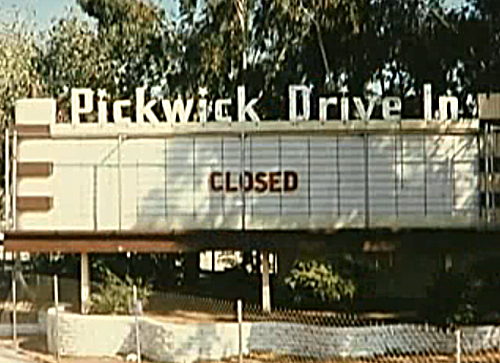
Of the venues who did manage to ante up the conversion costs most are still with us. While the days of over a thousand venues are permanently in our rear view mirrors, the industry believes there is hope for a resurgence. We need to have something to show what life was like when the boomer generation left their homes in pajamas, cuddled up in the backseat and watch the latest Disney film under the stars.
For a nostalgic trip back in time as well as an analysis of the drive-in phenomenon, a documentary was produced in 2014 about drive-ins. “The Definitive Story of the American Drive-in Movie” was directed by April Wright and is available on DVD in stores and via several streaming services.

Filmtools
Filmmakers go-to destination for pre-production, production & post production equipment!
Shop Now












